Menus
- 497 cc, 82 hp, 190 km / h, the first mass-produced turbo motorcycle
- A Power Ranger look for an expensive but efficient grand tourer
- 82 hp instead of 48 on the normal 500 CX
- Discovery
- In the saddle
- In the city
- On motorways and main roads
- On departmental
- Part-cycle
- Brakes
- Comfort / duo
- Conclusion
497 cc, 82 hp, 190 km / h, the first mass-produced turbo motorcycle
A Power Ranger look for an expensive but efficient grand tourer
The turbo, it’s a bit like the magic potion! Something that makes you strong and powerful, irresistible and sovereign. There is an element of mysticism in this influx of raw power, which happens suddenly and which, according to legend, is not controllable by all.. Violent, unpredictable, uncontrollable in the wet: the turbo has the reputation of bad boys.
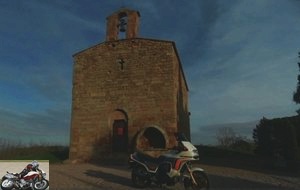
A turbo, ladies and gentlemen, it really values you the driver. At the time, it was displayed in large characters on the body! "Clear the road, peasants," the decorated vehicle seems to shout! "The Turbo will overtake you and it will be windy". Happy times when performance was still valued, when it was synonymous with progress. .
In terms of engines, the turbo is just that: progress. And also potato, but there was a time when the two (nostalgia …) went hand in hand. With a turbo, a small engine has the performance of a big one, a big one has even more performance and that’s cool. The idea is not new since it was in 1905 that the Swiss Alfred Buchi (1879 – 1959) filed a patent for a compressor powered by exhaust gases which sent air back into the engine in order to improve it. the power. It was the planes of the First World War that were equipped with this technology, then boats and locomotives in the 1920s..
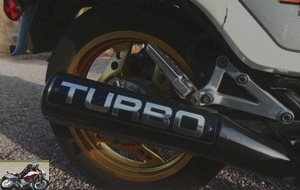
It is common to think that in cars, the turbo made its appearance in competition before being declined on more common models, but in fact, this is not true. The General Motors group was the pioneer in 1962 by simultaneously installing it on Oldsmobile Cutlass Jetfire V8 and the air-cooled flat six of the Chevrolet Monza Spyder. With the arrival of Germany, we went from exoticism to rigor: the BMW 2002 Turbo of 1973 and the terrible Porsche 930 Turbo of the end of 1974 were considered to be performance monsters at the time (which they were objectively). Saab followed with the refined 900 Turbo in 1977.
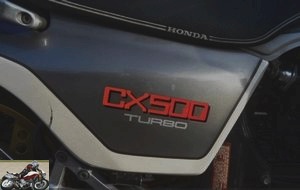
In competition, it was not until 1976 (victory of a Porsche 935 Turbo at the 24 Hours of Le Mans) and 1977 (arrival of Renault in Formula 1 with the V6 Turbo) for this technology to radically change the landscape of the starting grid. The first turbocharged supercar was the Ferrari 288 GTO in 1984 and today there are turbos everywhere. Really everywhere (a Renault Twingo 900cc has a turbo and most of its drivers don’t even know it). Even a Ford Mondeo or a VW Passat Diesel have twin-turbo variants, BMW installs three turbos at once on its 50d engines and Bugatti in stash 4 in the center of the W16 of its Veyron. But hey, we are not here on lerepairedescaisseux.com and to talk about the car, even if it must be recognized that, from a technological point of view, the world of motorcycles is rather following and it is still valid today. hui. Alas.
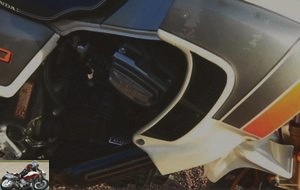
82 hp instead of 48 on the normal 500 CX
Because in motorcycles, apart from a few attempts at a compressor BMW in the 1930s, we had to wait. But it was worth the wait: as if they had concerted, the 4 Japanese draw almost simultaneously! And Honda, as often, does not do things like the others by choosing a V2 base when all his little comrades opt for 4 cylinders in line. Because, for motorcycle fans, the beginning of the 1980s was a real shock: at the beginning of 1982, Honda was the first to create a sensation with the CX 500 Turbo, the V2 of which, thanks to the contribution of the Sainte Turbine, released 82 horses. instead of 48 on the normal 500 CX! A few months later, Yamaha followed with its XJ 650 Turbo which developed 90 horsepower thanks to its 653 cm3 in-line 4 cylinders. In 1983, rebelote: the CX 500 Turbo has already disappeared, replaced by the CX 650 Turbo which reaches 100 horsepower. Suzuki joined the party with its XN 85, of which the 4 in line of 647 cm3 developed 85 horsepower; but it comes later and is less powerful than the others, too bad. As for Kawasaki, it lands the last, but in accordance with the image of the brand, with a monster: the ZX 750 Turbo from 1984 indeed develops the trifle of 112 horses. !
In 1982, the Honda CX 500 Turbo was sold for 40,184 francs. It was then the price of a large displacement of 1000 or 1100 cm3.
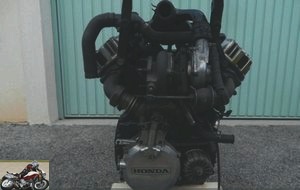
Discovery
Kitsch. And massive. The Honda CX 500 Turbo is blatantly from another era. Between the golden rims, the orange self-adhesive strips, the headlight optics that seem to come from a Citroën CX, the pie-style fairing and the large "Turbo" inscriptions on the exhausts and on the front of the fairing (but written in the other way around, to make its status of inferiority clear to whoever reads it in the rearview mirror!), the CX Turbo is typical of the 1980s, a decade that was uninhibited in many ways. The CX 500 Turbo is really a motorcycle apart and it has had time to make people talk about it, between its presentation at the Cologne Motor Show (Germany) in September 1980 and its effective marketing a year and a half later..
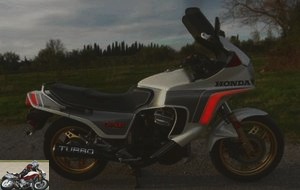
On closer inspection, two things are striking: its complete equipment as well as the quality of its construction and finish. Many believe, and quite possibly rightly so, that the Honda’s of the 1980s were possibly the most carefully constructed Japanese machines. Time has left its mark on the side covers, which are starting to crack and the pearly white takes on a different patina depending on whether it is applied to the plastic of the fairings or the metal of the tank, but for the rest, 34 years later, everything still works perfectly. The attention to detail is astounding: the part of the fairing, above the headlight optics, is held in place by a rope so that the bulb can be changed easily.

The dashboard is complete and very readable, with liquid crystals in its center that testify to the pressure of the turbo. There is also a digital clock, a fuel gauge, a water temperature gauge. The starter is automatic. The fuse box is directly accessible at the base of the dashboard. The handlebars are protected by a cover, as is the base of the brake and clutch levers. If we guess the gas plant, many elements are well hidden under the fairing and in the center of the V.
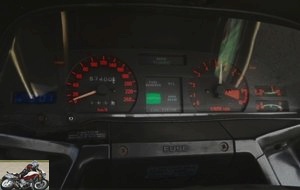
For a 500, the CX Turbo is a rather bulky machine. The thick saddle is an invitation.
In the saddle
Saddle? Or Sofa? Nowadays, no more sporty motorbike offers such softness. The passenger, too, will obviously be treated well. The 500 CX Turbo was so avant-garde that in some ways it doesn’t look its age: ergonomics are natural, with an upright and fairly relaxed riding position. The dashboard is complete and legible. Everything makes sense, everything works, the controls are soft and responsive as Honda has always known how to do..
On the handlebars, the knees naturally find their place in the notches of the tank and the top of the cylinders, enclosed by the fairing, protect them from the wind. In front, the massive fork crown and its small smoked and curved bubble guarantee a good protection and just let the gaze sweep the horizon, where this Turbo promises, in a flash, to teleport you with its powerful breath..
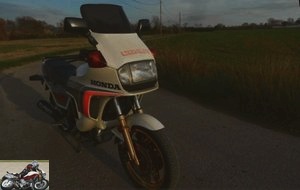
This is the first paradox of this bike: with its big nose perched high, it looks massive, but you just have to climb on it to understand that it integrates you completely and that she and you will be one. No motorcycle from this period offers this feeling and one can easily imagine the feeling of jubilation of the engineers at Honda when they did their wind tunnel and ergonomics work. They certainly had the feeling of having invented the motorcycle of the future. In a way, the CX was in line with that ideal of the 1980s, that of the Luigi Colani and the Franco Sbarro, where the man and the woman, always dressed in a skin-tight and plain leather combination, melted into the performances of the machine designed to defy the wind.
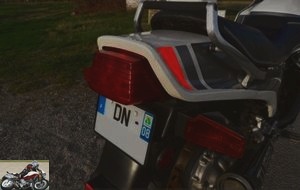
In the city
The CX 500 Turbo is a good and worthy Honda: by that mean the balance of its chassis has been extremely well thought out. At the same time, it weighs 239 kilograms dry, its center of gravity is high enough, it is complicated to park and weighs the weight of a dead donkey if you want to put it on its central stand. In short, you will understand that this is not his favorite terrain, even if his turning radius is quite correct..
The 497cc road-facing V-twin is pretty smooth, but it’s really hollow at low revs. Try a dual hill start and you’ll understand what it means to wax a clutch. Once underway, on the other hand, the CX 500 Turbo accepts to operate at low revs, in relative smoothness, without jerks of transmission or injection. The engine does, however, give off a certain heat in the city..

On motorways and main roads
We guessed it sporty and we discover a GT! On the main axes, the CX 500 Turbo impresses with the comfort of its saddle and the driving position, but also and above all, by the protection offered by its majestic fairing. We are fine. Very well. And we just want it to last, because the CX has a little "flying carpet" side, with padded controls and an engine that does not vibrate. Besides its generous fairing, the CX had other attributes of a large road: tubeless tires, cardan transmission, water-cooled engine…
Beyond the power (82 hp at 8000 rpm), it is the torque of the CX that is interesting. And this, on three levels: first, the gross value. 7.5 m / kg, not bad at all for a 500 cm3! Then, a speed of obtaining 4500 rev / min, it is rather low and that augurs a beautiful mechanical elasticity. Finally, the way: the CX 500 Turbo is on / off. Supple, but almost soft at low revs, it wakes up at 4500 rpm and then pushes with force, in the downright audible whistling of its turbine, the "popping" of the discharge valve being also very loud when one abruptly cut off the gas. The favorite exercise of the 500 Turbo: devour the kilometers at a sustained but still reasonable pace then, with a blast of a turbine, swallow the horizon, overtaking with unsuspected vigor.
On the last report, the turbo kicks in at around 4,500 rpm, or a good 100 km / h. With a solid twist of the handle, the V-twin wakes up and the scenery suddenly becomes closer. The way is just as tasty: unlike the legends that run on its account, the turbo of the CX acts without violence, without brutality, without the explosiveness of a 2-T, but like a big rubber band, very thick, with very rough rubber, which propels you forward with force but civility, without twisting the frame or mistreating the rear tire. In a few seconds, the counter goes from 120 to 180 km / h, a vigorous acceleration but despite everything very high, we just find ourselves catapulted forward by a fairly irresistible force..
The top speed (a good 190 km / h chrono) remains finally quite modest both in view of the look and the promises of this bike, but also because a good 550 "atmo" of the time (like a Kawasaki ZX 550 , for example), he stuck to the basques in the howl of his four-cylinder. Basically, what we hardly do today with such a machine, the CX 500 Turbo shows its limits in terms of stability..

On departmental
Suffering from its weight and high center of gravity, the CX 500 Turbo is by no means sporty and waddles fairly quickly on attack, although it remains healthy by rolling up quickly. However, the secondary network does not scare him, once we understand that it is necessary to privilege the exits of curves (with the bike well upright) rather than the entries. The CX 500 Turbo is first and foremost an engine! And, on the secondary network, it is an ally that allows straight lines to be shortened. You just have to understand, manage your inertia, your response time and accept the instructions for use. The 5-speed gearbox is quite smooth but does not like on-the-fly shifting. As for the gimbal, its effect is not too felt.
On the other hand, when we play, consumption soars and the CX can ask between 8 and 10 liters per hundred. The autonomy is then barely greater than 200 kilometers, with the 20 liters contained in the tank.
Part-cycle
The chassis of the CX 500 Turbo is classic, with a mono shock absorber at the rear and a fork which had, it was fashionable at the time, an anti-dive system. When we look at the size of the tires in relation to the power, we are afraid: the front is a small 100/90 x 18, the rear is a "generous" 120/90 x 17. Number of 125 cm3 have tires wider today. The tire index is H for speed; they will switch to V on the CX 650 Turbo.
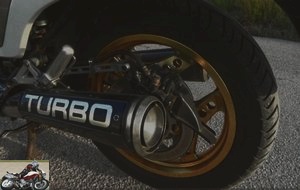
Brakes
Already at the time, the braking of the CX was considered correct in absolute terms, but a little tight in the end compared to the performance of the bike. The three discs have a diameter of 276mm and are clamped by single piston calipers. The diameter of the pistons will be revised upwards on the CX 650 Turbo, but the reviews will remain the same. Engine braking is quite weak which is amazing for a V-Twin.

Comfort / duo
This is one of the strengths of the CX 500 Turbo. Generous saddle, excellent aerodynamic protection, suspensions rather flexible without being too soft (travel of 130 mm at the front and 100 mm at the rear): the CX places its rider in excellent conditions. And the passenger does not have to complain either, especially as his presence has little impact on the performance and behavior of the motorcycle. The saddle is still as generous as is the grab bar and putting your feet just above the exhausts marked with a big "turbo", it’s still class..
Conclusion
The Honda CX 500 Turbo today is obviously a collectible motorcycle, if only because it was the first, if not the best. Certainly, some prefer its evolution by considering it more successful: indeed, the CX 650 Turbo will bring a real gain in performance and road enjoyment, with, in addition to its 100 horsepower at 8000 rpm, a copious torque of 10.5 m / kg at 4500 rpm and a top speed of 215 km / h chrono. The dry weight had also dropped to 235 kilos. But today, we no longer ride these motorcycles as we did at the time and our judgment is imbued with a little more affect..
The CX 500 Turbo is an endearing motorcycle, admittedly heavy, greedy and not as powerful as it should have been (but Honda engineers deflated the engine before going into production), but the quality of its manufacture, its comfort on board, the breath of its engine between 4500 and 8000 rpm, the delicious and obsolete sensations that it lavishes deserve all our interest.
It remains to find a beautiful survivor among the 5343 motorcycles produced in 1982, because its price can only rise. A beautiful CX 500 Turbo can now claim more than 5000 € and it is justified, because it marked history.
However, with the arrival of the Kawasaki H2 and the projects at Suzuki including the Recursion, the turbine engine has not had its last word..
Strong points
- Piece of history
- Kitsch is chic !
- Remarkable comfort
- Driving pleasure
- The pleasure of the turbo effect
- Ergonomics and protection
- Excellent build quality
Weak points
- Heavy weight
- Average braking
- Waddles on his suspensions on the attack
The technical sheet of the Honda CX Turbo
Test conditions
- Itinerary: 200 km of small and varied roads in the pretty, green and bucolic Belgian Ardennes.
- Motorcycle mileage: 57,000 km
- Problem encountered: none. Thanks to Olive (a man of taste who also rides in KTM 990 SMT, Yamaha 350 RD LC and Porsche Boxster S …) for the loan of his magnificent machine.
Related articles
-
Honda renews its big roadster. Retro, sporty, or both ? 4 cylinders in line, 998 cm3, 145 hp at 10,500 rpm, 104 Nm at 8,250 rpm, 212 kilos with full…
-
4 cylinders in line, 649 cm3, 95 hp at 11,000 rpm, 64 Nm at 8,000 rpm, 208 kilos, from € 7,199 Honda’s mid-size roadster passes Euro 4 standards and gets…
-
Discovery From the first approach, the NSR is reminiscent of a light CBR … Otherwise said, a super sporty, but with a smaller engine. For a 125, we…
-
A small roadster with a neo sport cafe look for A2 licenses … and others Single cylinder, 286 cm3, 31.4 hp at 8,500 rpm, 27.5 Nm at 7,500 rpm, 143…
-
Honda Crossrunner VFR800X test
From the road to the city by motor synthesis. The power of dreams, the credo of the Honda firm, inspires him for 2011, an atypical machine: the…
-
Japanese Spice Choper. When Honda introduced the Fury in 2009, no one believed it … what could have prompted a Japanese brand to create such an extreme…
-
Little pearl of Asia Introduced in 1984, the Honda 500 VF came at the start of the wave that saw Honda bet everything, or almost everything, on this…
-
Tame shrew Introduced year after the Yamaha 500 RDLC and at the same time as the RG 500 Suzuki, Honda unveiled its 2-stroke replica in 1985: the NS 400…
-
Flatteries of flat Appeared forty years ago (already!), The Honda 1000 GoldWing was the first behemoth produced in large series. A limousine on two…
-
Single cylinder 4-T, 25 hp at 8,500 rpm, 22.6 Nm at 6,750 Nm, 146 kilos fully loaded The Knacki Herta spirit of the motorcycle for 4999 € You have…
Consumption seems to be important and these days it really matters. Otherwise, this bike is very beautiful with an interesting price positioning, it could well make a career.